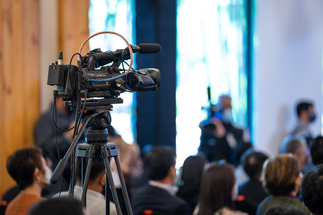
Picture this: You’ve rolled out the red carpet for your nonprofit’s event, snapped pictures and videos, invited donors to dance the night away, and raised important funds for your mission. While these funds have a long-lasting impact, the event itself is over in the blink of an eye.
What if you could repurpose your event content to continue serving your mission, even after your event’s grand finale? With some forethought and strategy, you can! Capturing your event via picture and video all while transforming it into marketing collateral can help you recruit volunteers, surpass your fundraising goal, and boost signups for the next one. Let’s explore some top tactics for transforming your event into marketing material.
1. Create a robust nonprofit marketing plan.
Behind every great event is a lot of planning, coordination, and promotion. This is when you should consider how you’ll turn your event into a marketing tool.
The best way to establish a track record of event success is to use a standardized nonprofit marketing plan for events. Getting Attention suggests outlining these important elements in a plan that accounts for:
- Detailed campaign goals and key performance indicators (KPIs). For instance, if your goal is to boost signups for your next event, you could track the conversion rate from your marketing materials to your signup form.
- Target audience personas. Stepping into your target audience’s shoes allows you to understand their motivations and preferences on a deeper level. Create a few detailed personas for each segment of your target audience, complete with details like name, occupation, gender, age, and income.
- A rough schedule for posting content. You don’t have to have every post planned out yet, and for what you do plan, allow yourself to change it if needed. Your content schedule should be more of a general guide so you know what kinds of materials you should prepare to collect.
- Brand guidelines. Think of ways to channel your event’s theme into your marketing materials. For instance, when hosting a gala, you might use an elegant typeface on your social media banners.
Ironing out these details in advance will help you appeal to the right audiences during and after the event.
2. Get nonprofit influencers on board.
You likely already understand the importance of social media in your marketing strategy. Still, you can take your efforts to the next level by leveraging popular nonprofit personalities, also known as influencers. Partnering with an influencer with a significant following and reputation can draw attention to your cause and establish the quality of your events. Here’s how to forge relationships with nonprofit influencers for your event marketing:
- Generate a list of potential partners. Ideal nonprofit influencers to collaborate with should have a loyal following on social media, post high-quality content, and align with your values. Start by looking in your inner circle—do any of your nonprofit colleagues have a significant following and would be willing to support you? It’s a lot easier to source influencers you already know than to build relationships from scratch. You could also ask your marketing agency to provide suggestions for influencers to pursue.
- Determine what the influencer’s role will be. The influencer’s part in your event and the marketing materials will vary depending on the type of event and their area of expertise. For instance, you could simply use their participation in the event on marketing materials to cement your credibility, or you could use a quote from them to grow interest in future events. Ensure the influencer knows ahead of time what’s expected of them and how you’ll use their likeness.
- Offer value to the influencer. Influencers’ time is valuable, so you need to make your proposal worthwhile. Consider compensating them for their participation, promoting their upcoming initiatives, or offering them volunteer hours.
With a VIP at your event, you’re sure to get more attention for your initiatives and lock in RSVPs.
3. Encourage user-generated content on social media.
While planning your event marketing strategy, remember that we’re in an age where anyone can become a part of your outreach campaign thanks to digital channels like social media. Social media’s interactive elements provide a great way to showcase your attendees and leverage user-generated content. Use the following features to encourage users to post event-related content on social media:
- Hashtags. Hashtags group all the posts related to your event in one place. This makes it easier for current and potential attendees to find information, updates, and discussions about the upcoming festivities. Ensure your hashtag is branded to your nonprofit, relevant to the event, and not too long or complicated.
- Geofilters. This feature is similar to hashtags but provides a location-based tag instead of a phrase-based tag. Platforms like Snapchat allow users to create branded geofilters that can only be accessed within a specific area. By creating an eye-catching geofilter that includes the event name, logo, and relevant messaging, you can encourage engagement from users nearby. This, in turn, will foster a sense of community and increase your event’s visibility.
- Submission contest. Take both of these ideas to the next level by gamifying them with a contest. Before the event starts, challenge participants to take pictures or videos that align with your chosen theme, such as “best costume” for a masquerade ball. Then, have your attendees post their content under a hashtag or geofilter for a chance at winning a small prize, like a gift basket. Feature the winner’s content on your social media pages or in your newsletter.
Empowering your attendees to share the best parts of their event experience online can come across as more genuine than preplanned marketing efforts and can funnel new viewers straight to your nonprofit’s page.
The Bottom Line
If you’re looking for guidance on your event marketing push, you can supercharge your approach by working with a nonprofit marketing agency. Fifty & Fifty recommends working with an organization that understands the unique needs of nonprofits so you can get the most relevant guidance.
Whether you work with an agency or not, remember that events can serve as so much more than a fundraising conduit. As long as you leverage all of your resources, from attendees to staff, you can make a big impact on both your mission and your RSVP list.
About the Author

As Founder and Creative Director of Fifty & Fifty, Javan is the tip of the proverbial spear. Javan started his digital design career 20 years ago as Art Director for what is now one of the world’s largest digital agencies (Mirum, a JWT Company). He then moved on to Invisible Children where he was responsible for managing the team and all digital assets through the entire historic Kony 2012 campaign. At Fifty & Fifty, Javan has participated in and led every project, including 300+ websites, campaigns, and brands.





